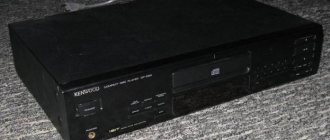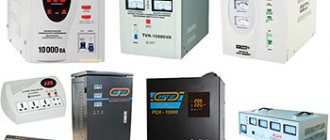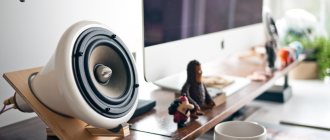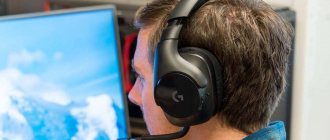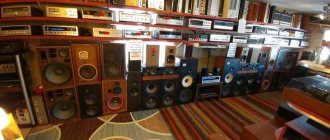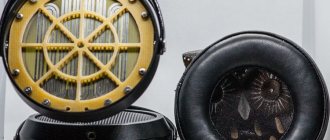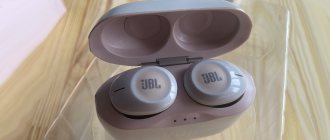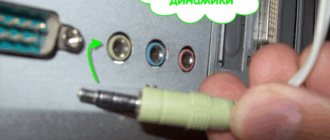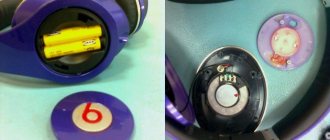- home
- →
- Radio engineering of the 19th and 20th centuries (TVs, acoustics, optics, etc.)
- →
- Acoustic systems, speakers, loudspeakers by USSR manufacturing plants
- →
- Acustic systems
- →
- post-war speaker systems
- →
- Thorium plant Moscow
- →
- acoustic systems of the Moscow Thorium plant
Description
Electronics 75AC-065 - Acoustic system with bass reflex. Produced since 1989 at NPO Toriy, Moscow. AS "Electronics 75AC-065" is designed for high-quality reproduction of music and speech programs in stationary living conditions. The recommended power of a high-quality household amplifier is 6 – 75 W. The high-fidelity acoustic system “Electronics 75 AS-065” is a new development in the range of modifications of acoustic systems in the Hi-Fi category “Electronics”. The new acoustic system is characterized by the traditional use of metal diffusers, 3-way construction, bass-reflex acoustic design and classic design. Refinement of the main components of the acoustic system - electrodynamic heads and filters in accordance with the latest achievements in the field of sound reproduction has made it possible to increase reliability, ensure trouble-free operation of the acoustic system and the reliability of reproduction of any program material. The range of technical parameters of the acoustic system 75 AC-065 is fully internationally certified (IEC). The recommended maximum long-term power of a shared amplifier is no more than 100 W per channel. At the same time, an acoustic effect sufficient for the consumer in a medium-sized living room (about 20 m2) due to the high efficiency of the speaker system can be obtained from an amplifier with an output power of only 6 W per channel. A feature of the speakers is the use of stable metal diffusers in all three speaker heads and high sensitivity (efficiency). The speaker body is made in the form of a rectangular, non-separable box made of 16 mm thick particle board (in order to increase the rigidity of the body walls, it can be made from 18 mm thick board; the weight of the speaker can reach 34 kg), trimmed with valuable wood veneer. The housing design includes elements that increase the rigidity of the housing and reduce the amplitude of vibrations of the walls, in particular, a spacer made of perforated chipboard. The front panel of the speaker is finished with veneer, the thickness of the front panel is 17 mm. A set of heads with metal diffusers was used, ensuring stability of the speaker characteristics over time and under the influence of various environmental factors. A set of heads similar to those used in the 100AC-063 acoustic system. The heads are installed on the front panel of the housing symmetrically relative to the vertical axis of the speaker. In addition to the heads with decorative flanges and a diffuser holder, on the front panel of the speakers there are two symmetrically located holes with a diameter of 60 mm, which are the outputs of bass reflex tubes 140 mm long, knobs for high and mid frequency level controls with a nameplate on which the divisions of the level controls and the name of the system are printed. The limits of regulation of the level of mid frequencies are -20 ... 0 dB, high frequencies -20 ... +3 dB. The front panel also has special plastic bushings for attaching a removable decorative frame with fabric. The geometric dimensions of the bass reflex pipes ensure that it is tuned to a frequency of 45 Hz. The internal volume of the speaker is 65 l. To reduce the influence of the resonances of the internal volume of the housing on the frequency response of sound pressure and the sound quality of speakers, the latter is filled with a sound absorber. Electrical filters are mounted inside the housing on a single board, providing electrical separation of low-, mid- and high-frequency speaker bands. Crossover frequencies: between LF/MF - 700 Hz, between MF/HF - 5000 Hz. The design of the filters uses resistors of the PEV-10 type, capacitors of the MBGO type, and inductors on “air” or ferrite cores. On the back wall of the speaker housing there is a cover with special terminals installed on it, allowing you to connect the supply wires. The connection polarity is marked on the terminals. The removable decorative frame included in the speaker kit is covered with a special fabric that has acoustic transparency. The following speakers are installed: — LF GD-01-25; — SCH GD-01-230; — HF GD-01-1000; Technical characteristics: 3-way floor-standing speaker with bass reflex Frequency range: 40 (-18 dB) – 25000 Hz (±1.5 dB) Sensitivity: 90 dB Average sound pressure level: 96 dB Directional characteristic of the speaker, measured by the deviation of the frequency response of the sound pressure at angles to the acoustic axis: in the vertical plane ±7°: ±3 dB in the horizontal plane ±25°: ±3 dB Harmonic distortion at sound pressure 96 dB in the frequency range: 63 – 250 Hz: 2% 250 – 1000 Hz: 1.5% 1250 Hz: 1.4% 1600 Hz: 1.3% 2000 – 6300 Hz: 1% above 6300 Hz: 2% Resistance: 8 ohms Minimum impedance value: 6.4 ohms Operating power: 4.5 W Nameplate power: 75 W Short-term power: 125 W Long-term power: 100 W Maximum sinusoidal power in the frequency range: 25 – 500 Hz: 36 W 500 – 5000 Hz: 18 W over 5000: 6 W Weight : 40 kg; Dimensions (HxWxD): 760x390x350 mm
Modernization Electronics 75 AC 065 Vladimir - 24.9.01, 15:11People !!! Tell me what can be done with this acoustics and where I can find a description of it.
Well let me answer... — 25.9.01, 10:44
Hello!
I understand, the typical advice is to throw it away. But, nevertheless, as the owner of this acoustic system for a long time, I can recommend operations traditional for this class of products: - replacing capacitors with the highest quality ones (MultiCap, etc.). Perhaps it’s not necessary in the low-frequency channel, there are MBGOs there. — replacement of internal wiring with high-quality wire. - body damping. I used a coating inside with hard linoleum (for the time being) + a layer of auto sealant on it (about 1 cm). The result is a significant reduction in cabinet resonances. — raised above the floor (about 40 cm) on stands + spikes. You can make it yourself (order it at the factory). Less dependent on location, bass more natural. — I replaced two coils in the LF/MF (which had a core) with homemade ones (without a core, wire diameter 1.7 I think). — extreme — removal of the separation filter board from the case (as a side effect — some compensation for the decrease in internal volume during damping, see paragraph 2). Tri-wiring. You can play around with different cables for each band. Filter boards are in the immediate vicinity of the PA (such as on the next shelf of the rack).
In my untrained opinion, this product (including modifications) is worth its money. Well, definitely not the S-90. But, on the other hand, you can’t get rid of the metal domes of the HF and MF, they have their own coloring. Rock, ambient, new age - very pleasant to listen to.
I have a description (passport, diagram), although it’s far away and I won’t be able to get it in the near future. I can send it somewhere in a week, please include your e-mail.
Good luck
Sergey.
Re: Well, let me answer... Vladimir - 9/25/01, 16:57
Thanks for the worthy answer! I have already done a little, namely: I covered the inner surface with Lenolium and replaced the wires. In principle, the unit has already become much better. Is it worth rewinding the coils, taking into account the increase in the cross-section of the wires?
Re: Well, let me answer... — 25.9.01, 17:15
It’s a business matter, but, in my opinion, this is far from a priority task. Yes, and winding such monsters - you can resist. Better to work on capacitors... As my experience shows, linoleum alone will not be enough. There are no spacers inside.
Re: Well, let me answer... Vladimir - 26.9.01, 08:03
My speakers have spacers! Sergey, what capacitors do you recommend? Thanks in advance!
Re: Well, let me answer... — 26.9.01, 10:07
> My speakers have spacers! Perhaps I also have spacers, I just don’t remember now, but somehow it hasn’t been postponed...
As for capacitors, AudioCap PPMF would probably be just right (if it’s affordable). To be honest, in those days I didn’t have much money, and I was a little short on information. So, this very important point was not fulfilled. Another option - Solen Fast Cap - is cheaper (about $50..60 for a midrange/high frequency kit). Ask around in Gyros and see what the prices are there. I can’t suggest anything from domestic ones - there is no information. Look in the archives - such topics have been raised.
Good luck
Sergey.
Re: “Sorry to intrude” (c) S.M. Genn — 26.9.01, 11:44
> My speakers have spacers! > Sergey, what capacitors do you recommend? > Thanks in advance! ========== Can you practice on our MBGs? without housing, K71-7, FT-3. :-))
To sum it up Vladimir - 9/26/01, 12:04
I got the speakers for $100. Taking into account the replacement of wiring and capacitors, $150. What can compare in sound for that price? The speakers are connected to Horman AVR 3000. At the rear there are modernized Soyuz 50 AC 012 (type S90). Of course, I understand that many things sound much better, but the price is different. What can you say about this, good people?
Re: Summarizing — 26.9.01, 12:32
> I got the speakers for $100 > Taking into account the replacement of wiring and capacitors, $150
If you replace the wiring and capacitors, you will want to replace the speakers (okay, if not all at once). And there is no end to the creeping upgrade. The only limit is money.
At first, there is no point in bothering with expensive wires and capacitors. The wire is ours, original, but with a larger cross-section. If there are electrolytes (which is unlikely, I haven’t seen them for a long time), we replace the capacitors with MBGO ones. We replace the coils with a core with the same ones without a core. If there are switches for midrange and treble sensitivity, we throw them out, having previously determined the optimal position. Install new input terminals.
Further. We carefully inspect the body for the quality of the adhesive seams, absence of cracks, and overall tightness. We eliminate the observed deficiencies. We cover the body from the inside and fill it with a sound absorber (if it wasn’t there before).
At this point, the first stage can be considered completed. We listen carefully to the result, and, if there is a desire, we continue.
At the second stage we deal with the speakers. Our traditional midrange speakers 20 - 30GDS are dregs. If you have the desire and money, we exchange it for import. Otherwise, we open the old files of the Radio magazine and look there. The most common recommendation is to replace the GDS with 5GDS, modified according to some known method. Surely people will post links on the Internet on this topic.
We're doing an audition. If the result is not satisfactory, we change the tweeters. Here, unfortunately, it is difficult to find anything domestic that is better than it is. But there is now a large selection of imports.
Now you can replace the bass (again with import).
And only after this the third stage is the replacement of wiring and capacitors with expensive imports.
Re: Summarizing — 26.9.01, 12:36
> And only after this the third stage is the replacement of wiring and > capacitors with expensive imports.
And the final 4th stage. We make new beautiful and durable cases. Do you know what happened? :-))))
Re: Summarizing — 26.9.01, 12:56
> And the final 4th stage. We make new beautiful and durable > cases. Do you know what happened? :-))))
The beauty is that you can stop at any stage. The result is guaranteed to be better than the original. In addition, after any of the completed stages we have a fully operational device.
Completely homemade speakers do not have the above advantages.
Reply to Slava and Dmitry Vladimir - 26.9.01, 13:08
Guys, judging by your suggestions, you have never dealt with this acoustics. In this acoustics, all three speaker heads use diffusers made of foam metal and aluminum foil. There is no point in replacing them with our other ones. Regarding the case, everything is fine there, with the speakers weighing 40 kg. They are made from 20 mm chipboard. There are spacers in two directions. The upper and lower walls are made of two glued plates with a total thickness of 40 mm. The only thing missing in the body is the presence of decent sound-absorbing material.
I found a link here... — 26.9.01, 16:36
It might do. True, it is about AC75-001, but it contains generally universal information.
Boris
push it nicely
Re: Reply to Slava and Dmitry — 26.9.01, 19:20
> The only thing missing from the casing is the presence of > decent sound-absorbing material. Yes, yes, I remember, and I threw cotton wool there. Then I talked to one person - so at one time he rewound the coils of these speakers. He says it has gotten better, but this is completely extreme. As for the standard capacitors (K6-17, if I’m not mistaken), I would first of all replace them with something decent.
Sergey.
PS The thing is really not so bad that you wouldn’t try to upgrade it.
